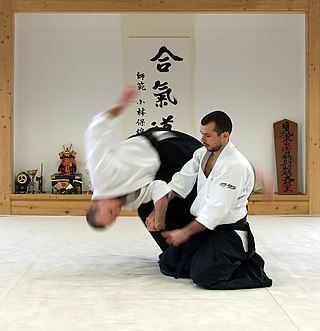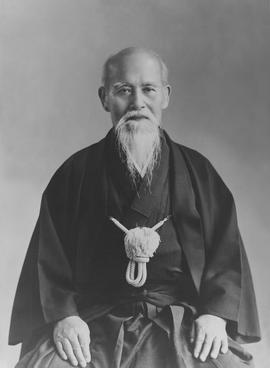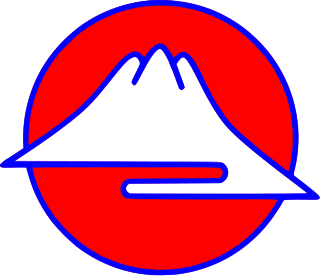
Aikido is a modern Japanese martial art which is split into many different styles including Iwama Ryu, Iwama Shin Shin Aiki Shuren Kai, Shodokan Aikido, Yoshinkan, Renshinkai, Aikikai, and Ki Aikido. Aikido is now practiced in around 140 countries. It was originally developed by Morihei Ueshiba, as a synthesis of his martial studies, philosophy and religious beliefs. Ueshiba's goal was to create an art which practitioners could use to defend themselves while also protecting their attackers from injury. Aikido is often translated as "the way of unifying (with) life energy" or as "the way of harmonious spirit". According to the founder's philosophy, the primary goal in the practice of aikido is to overcome oneself instead of cultivating violence or aggressiveness. Morihei Ueshiba used the phrase masakatsu agatsu katsuhayabi" to refer to this principle.

Morihei Ueshiba was a Japanese martial artist and founder of the martial art of aikido. He is often referred to as "the founder" Kaiso (開祖) or Ōsensei (大先生/翁先生), "Great Teacher".
Morihiro Saito was a teacher of the Japanese martial art of aikido, with many students around the world. Saito's practice of aikido spanned 56 years, from the age of 18, when he first met aikido founder Morihei Ueshiba, until his death in 2002.
Iwama-style Aikido(岩間合気道) is the style of aikido that was taught in Iwama by the founder of aikido, Morihei Ueshiba, and especially the lineage passed on through Morihiro Saito, a close disciple who was given responsibility over Iwama dojo by Ueshiba.
The Iwama Dōjō is a dōjō built by the founder of aikido, Morihei Ueshiba, who lived there from 1942 until his death in 1969. It is located in the former town of Iwama and became an important historical location for the development of aikido and "a Mecca to the aikido community." This dojo is also where Morihiro Saito, one of the founder's closest students, learned and taught aikido from 1946 until 2002 developing what is often referred to as the Iwama Style.

Koichi Tohei was a 10th Dan aikidoka and founder of the Ki Society and its style of aikido, officially Shin Shin Toitsu Aikido, but commonly known as Ki-Aikido.

Kazuo Chiba was a Japanese aikido teacher and founder of Birankai International. He served for seven years as uchideshi at the Aikikai Hombu Dojo before being dispatched abroad to help develop Aikido internationally. He held an 8th dan in Aikido, issued by Aikikai world headquarters in Tokyo, Japan and was active in Aikido for over 50 years.

Shoji Nishio was a Japanese aikido practitioner and innovator. He held the rank of 8th dan shihan from the Aikikai. He was a student of Aikido founder Morihei Ueshiba and practiced along with Seigo Yamaguchi and Hiroshi Tada. He achieved multiple high ranking honors in other martial arts, most notably Iaido, Judo, Karate.

Jan Hermansson was one of the first aikido pioneers in Sweden, and a respected aikido practitioner in the country. His rank was 7th dan shihan in the aikido organisation Aikikai.

Fumio Toyoda was a Japanese aikido teacher and lay Zen master who taught extensively in the United States and Europe. He is one of few teachers to explicitly teach aikido from the perspective of Zen Buddhism.

Yoseikan Aikido is the aikido taught at the Yoseikan Dojo in Shizuoka, Japan, under the direction of Minoru Mochizuki.
Kiyoyuki Terada was a Japanese aikido teacher. He was ranked 10th dan in Yoshinkan Aikido and served as the most senior instructor in Yoshinkan Aikido until his death.

Joseph 'Joe' Haridas Thambu is a teacher of Yoshinkan Aikido, currently ranked 8th Dan, Shihan.
Nafudakake is a Japanese method of displaying all the names of the members in a group by collecting the names on individual plaques called nafuda and hanging them together in a specialized case called kake. Nafudakake can be found in traditional art forms such as chadō, in modern art forms such as judo, at Shinto shrines and in some modern organizations such as volunteer fire departments. In English, the term is most commonly associated with Japanese martial arts, and nafudakake are commonly considered an element of a traditional martial arts dojo.
Hiroshi Kato; was an Aikido Master. He lived in Tokyo, Japan, and travelled the world teaching the principles of Aikido. A former student of Morihei Ueshiba, Sensei Kato taught from 1986 onwards in his Dojo "Suginami Aikikai" located in the Ogikubo district of Tokyo and has over 55 students.
Munenori Kawai (1931-2010) was an 8th dan aikido practitioner and acupuncturist, who held the roles of President of the South American Aikido Federation and Vice-President of the International Aikido Federation. He was responsible for the introduction of aikido to Brazil in 1963.
Shizuo Imaizumi (今泉鎮雄), born 1938) is a Japanese aikido teacher. He holds a rank of 7th dan from the Ki Society, but broke away from the Ki Society in 1987 to found the Shin-Budo Kai style of aikido.

Robert Mustard is a teacher of Yoshinkan Aikido. He is currently ranked 8th Dan, Shihan.

Jacques Payet is a practitioner of Yoshinkan-style aikido. He was the longest-serving non-Japanese uchi-deshi of Yoshinkan founder Gozo Shioda and is ranked Hachidan in the Yoshinkan organization, with the honorific Shihan. He is the founder and head instructor of Mugenjuku dojo and the Mugenjuku Kenshusei program in Kyoto, Japan. He is also the originator of the well-known Senshusei Course, a translator of several important works in aikido, and a guest instructor in demand around the world.

Stanley A. Pranin was an American martial artist, founding publisher, and editor-in-chief of Aikido Journal. Pranin, a researcher and archivist of aikido, has written and published several books and many articles about aikido, Daito-ryu Aikijujutsu, and Morihei Ueshiba and was an influential figure in the aikido world.












